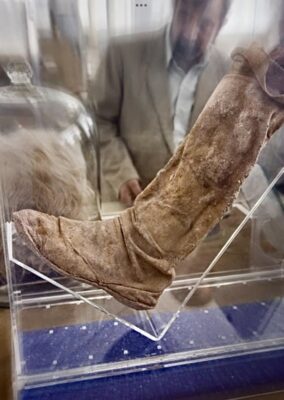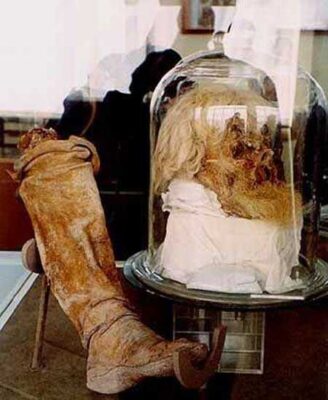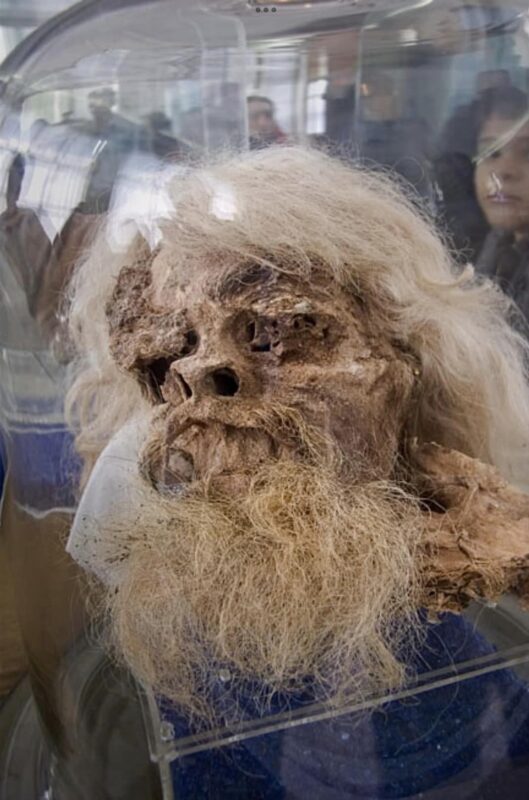Discovered in 1993 in the Chehrabad salt mines of Zanjan Province, Iran, the Salt Man is one of the most important and remarkable archaeological finds in ancient Persia. This incredible discovery provides an extraordinary insight into the past, offering clues about life in ancient Iran. Let’s explore ancient civilization with archeology.dulichvn.net..

The Discovery of the Salt Man
In 1993, miners working in the Chehrabad salt mines stumbled upon the remains of a man that had been preserved for over 1,700 years. Alongside his body, miners found a variety of artifacts that were buried with him, including a foreleg encased in a leather boot, three iron knives, a woolen half-trouser, a silver needle, a sling, fragments of leather rope, a grindstone, a walnut, pottery shards, intricately designed textile pieces, and several broken bones. These objects provide a glimpse into the everyday life and culture of ancient Iran.
The Appearance of the Salt Man
What makes the Salt Man stand out is his distinctive appearance. His long hair, beard, and a golden earring in his left ear suggest he held a high social status. These features imply that he could have been a wealthy merchant, soldier, or an influential individual in his society. The presence of such personal items, including jewelry, speaks to the Salt Man’s possible role as someone of significance during his time.
Dating the Salt Man’s Remains
The Salt Man’s remains have been dated through scientific methods, helping to pinpoint his era. The remains have been linked to the Sassanid era (224–651 AD), and further discoveries at the site revealed additional bodies, including a woman, that were from the Achaemenid period (550–330 BC). Studies by Oxford and Cambridge further confirmed the timeline, providing valuable information about life in ancient Persia.

The Salt Man’s Blood Type and Legacy
The Salt Man’s remains offer not just a glimpse of his physical appearance but also scientific insight into his health and biological makeup. Hair analysis revealed that he had blood type B+, which adds another fascinating layer to the discovery. This analysis provides a unique opportunity to study the genetics of ancient Persians, shedding light on human biology during that era.
Preservation and Modern Study
Today, the Salt Man’s remains are carefully preserved and displayed at the Ancient Iran Museum in Tehran. His discovery is one of the most significant archaeological finds in Iran, offering invaluable information about the Sassanid and Achaemenid periods. As a result, the Salt Man serves as a symbol of the cultural and historical richness of ancient Persia.
Importance of the Salt Man in Archaeology
The Salt Man continues to be a key piece in understanding ancient Persian life and culture. His discovery, along with the artifacts found with him, provides researchers and historians with important insights into the lives of people in ancient Iran. This exceptional find highlights the sophisticated craftsmanship and cultural practices that existed in Persia over a millennium ago.

Conclusion: A Glimpse into Ancient Iranian Life
The Salt Man, with his well-preserved body and intriguing artifacts, offers a rare glimpse into the world of ancient Persia. His discovery has not only advanced archaeological research but also captured the imagination of many who are fascinated by the mysteries of ancient civilizations. As one of Iran’s most important archaeological treasures, the Salt Man remains an essential symbol of ancient Persian history, providing a tangible connection to the past.


CÁC TIN KHÁC
Mark Twain & Olivia Langdon: A 36-Year Love Story Filled with Laughter and Devotion
The Tollund Man: A 2,400-Year-Old Mystery Preserved in a Danish Bog
Skara Brae: Scotland’s Hidden Neolithic Village
Porta Nigra: The Hidden Depths of Trier’s Iconic Roman Gate